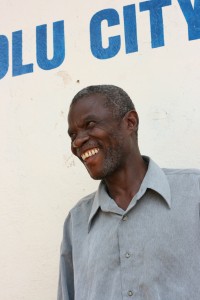
John V. Lombeh, Bopolu Central High School’s vice principal for instruction, says lack of water is a major challenge for his school. Photo by Timothy Spence
BOPOLU, Liberia | When students return to the classroom at Bopolu Central High School this year, there will be something not seen at the school since it reopened after Liberia’s long civil war.
Senior-class women.
In a milestone for a school struggling with a gender gap, eight girls are expected among Bopolu’s 24 seniors. While Bopolu’s primary grades are more gender-balanced, school attendance falls sharply after the mandatory first six years of instruction, most drastically among young women.
“I’m telling you that a single female has not graduated from this school,” said John V. Lombeh, the vice principal for instruction. “The good thing is that we are proud to announce to you that we will be having our first batch of females graduating from secondary school this new academic year.”
In a nation with Africa’s only female president, Liberian girls are outpaced by boys in educational enrolment, retention, and completion rates from the earliest grades through university. Nationally, for every 10 boys in primary school there are nine girls; for every 10 boys in high school, there are fewer than seven girls, and in some rural high schools like Bopolu, there are none at all. Only 18 percent of girls who make it to high school graduate, compared with 25 percent of boys.
Girls also have few role models in school. Just 12 percent of primary school teachers are women, and they account for 5 percent of junior high and 3 percent of high school educators, according to the Ministry of Education.
The Liberian government and international donors such as the UN children’s agency, UNICEF, are trying to improve educational conditions and opportunities for girls through special learning opportunities and inducements. Female education is listed as a priority in the government’s 2010 Education Sector Plan, with calls for erasing gender disparities within a decade.
That would reverse one of the more lasting traumas of the 14-year Liberian civil war that ended in 2003: a generation of children who had little or no access to schools. The Education Ministry estimates that more than half of schools were destroyed. Those that survived operated irregularly and often without resources, drawing children into the conflict and fostering illiteracy. According to the government, 69 percent of Liberian men and 41 percent of women can read and write.
Besides national education plans, there are promotional programs aimed at encouraging girls to remain in school. Billboards along with radio and television jingles promote female education. One such advertisement says: “When you educate a woman, you educate an entire nation.”
In Bopolu, the provincial capital of Gbarpolu County in northwestern Liberia, officials say extra food rations and female-only study classes are among the inducements being offered to keep young women in school.
Mohammed Kamara, a teacher and special assistant to the county education officer, said female primary-school students are getting free books and uniforms, and that girls in his district are receiving food rations for their families once a week with support of the World Food Program.
The food distribution program is provided in much of rural Liberia and typically consists of cooking oil and bags of bulgur wheat, according to Quoi Beyan, a WFP official in Gbarpolu County.
While food and other targeted programs having been credited with spurring female attendance, schools still struggle to overcome tradition-bound families who want girls to remain at home to work or to attend traditional home schools. Liberia’s high adolescent pregnancy rate – half of Liberian girls have a baby by the time they are 18, according to the World Health Organization – compound the challenge of keeping girls in school.
“We parents too have a major part to play in the reason of low girls’ education,” said Semaila Swaray, head of the Bopolu Parent-Teachers Association. “Most parents take the girls out of school for farm work. Some of them prefer traditional school.”
Swaray said efforts were being made locally to maintain a balance between both formal education and rural traditions. “We are trying to see how best we can come out with a schedule for both the traditional school and the other [formal] school,” he said.
Starting this year, parents who don’t send their daughters to school may face more concerted action: school authorities are threatening to prosecute anyone defying the 2006 law that created free but obligatory education through grade six.
But school officials are hoping that attitudes will change, especially with the prospects that Bopolu’s first eight women will graduate in 2011, out of Bopolu’s total primary through senior enrolment of more than 1,300. “We pray they will,” said Lombeh. “When they graduate, more will want to follow.”
GENDER IMBALANCE: LIBERIA’S PUBLIC SCHOOL ENROLMENT
National population: 3.5 million; population under 18: 1.8 million
Net school enrolment rate: 5 %*
Primary School: 308,748, 55 % male
Junior High: 40,667, 60.6 % male
Senior High: 16,212, 68.9 % male
Accelerated Learning Program: 65,345, 54 percent male**
* Net enrolment is based on the number of pupils attending classes appropriate to their age.
** Designed to compress six years of primary education into three to accommodate children older than 15 who did not attend school during the civil war years. One-third of these students are over the age of 18.
Sources: UNICEF, Ministry of Education National School Census Report (2008), Education Sector Plan (2010)
